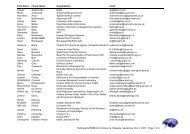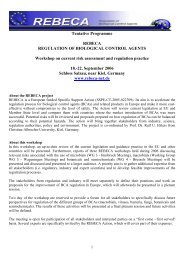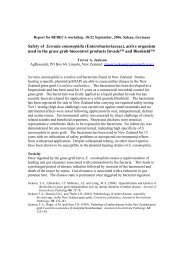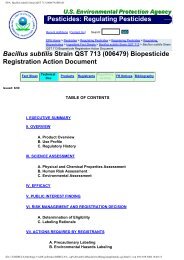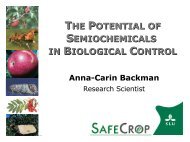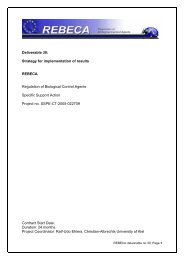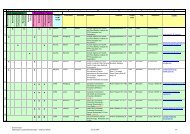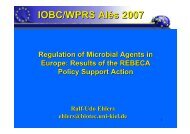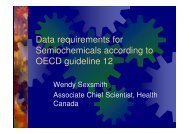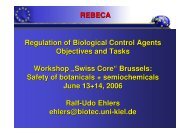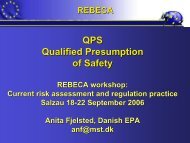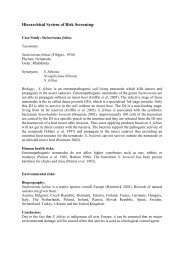Deliverable 28: Specification of low risk products REBECA ...
Deliverable 28: Specification of low risk products REBECA ...
Deliverable 28: Specification of low risk products REBECA ...
Create successful ePaper yourself
Turn your PDF publications into a flip-book with our unique Google optimized e-Paper software.
Further more the substances which are qualified as the fol<strong>low</strong>ing can not be regarded<br />
as <strong>low</strong> <strong>risk</strong> either:<br />
• persistent (half life <strong>of</strong> less than 60 days)<br />
• endocrine disrupter<br />
• bioaccumulative and non readily-degradable.<br />
Article 46 sets timelines for the authorization <strong>of</strong> plant protection <strong>products</strong> based on<br />
<strong>low</strong> <strong>risk</strong> substances. The member state shall within 90 days decide whether to<br />
approve an application for authorisation <strong>of</strong> a <strong>low</strong>-<strong>risk</strong> plant protection product. This<br />
period should only be 60 days in case an authorisation has already been granted for<br />
the same <strong>low</strong>-<strong>risk</strong> plant protection product by another Member State located in the<br />
same zone. However, in case the Member State will need additional information, it<br />
shall set a time limit not exceeding 6 months for the applicant to supply it.<br />
These timeframes are shorter than those suggested for active substances that are<br />
not regarded as <strong>of</strong> <strong>low</strong> <strong>risk</strong> (article 36). For those the timeframe is 12 months with the<br />
possibility <strong>of</strong> asking for additional information within a period <strong>of</strong> further 6 months.<br />
Article 23 provides criteria for basic substances and extends the period <strong>of</strong> their<br />
approval to an unlimited time. The basic substances will have to be applied included<br />
into a separate list. Article <strong>28</strong> states that plant protection <strong>products</strong> only containing<br />
basic substances (from this list) do not need to go through a national authorization in<br />
order to be placed on the market.<br />
The criteria for <strong>low</strong> <strong>risk</strong> substances are clearly made with chemical active substances<br />
in mind. First <strong>of</strong> all, there is a general <strong>risk</strong> <strong>of</strong> micro-organisms being sensitizers,<br />
which would thus right away disqualify them as <strong>low</strong> <strong>risk</strong> substances. However, so far<br />
no proper guidelines are available that can be used to carry out studies in order to<br />
investigate the sensitising properties <strong>of</strong> micro-organisms. In the data requirements for<br />
micro-organisms (Annex IIB to Directive 91/414/EEC) which are listed in Dir.<br />
2001/36/EC, it is mentioned that it is not necessary to present data on sensitisation,<br />
due to this lack <strong>of</strong> guidelines, but in this case the micro-organism is considered to be<br />
sensitising.<br />
.<br />
Secondly, the three terms: persistence, bioaccumulative and non readily-degradable<br />
and endocrine disrupters are all terms originating from the classification <strong>of</strong> chemical<br />
active substances. These criteria do not take into account that e.g. micro-organisms<br />
are naturally occurring substances.<br />
Biocides<br />
In the Biocide directive 98/8/EC the active substances regarded as being <strong>of</strong> <strong>low</strong> <strong>risk</strong><br />
are included into a specific list: 1A. The criteria for substances to be included into this<br />
list are quite similar to the criteria which are now suggested included in the new<br />
regulation on plant protection product. However, the biocide criteria does not include:<br />
toxic, very toxic, explosive and endocrine disrupters.<br />
4



